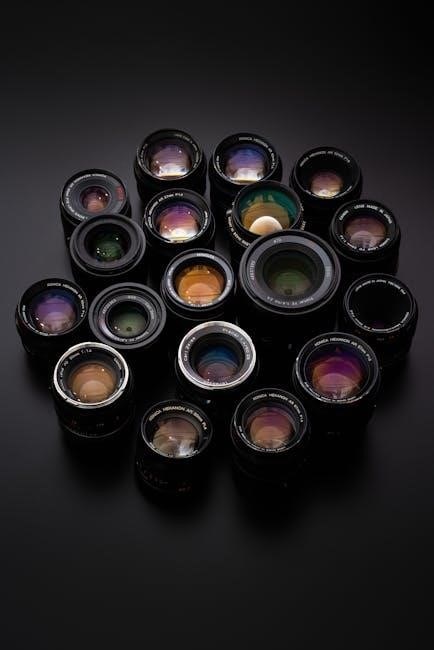Yamaha RX-V673 Manual: Comprehensive Guide
Unlocking the full potential of your Yamaha RX-V673 AV receiver requires a deep dive into its comprehensive manual․ This guide serves as your roadmap, providing insights into setup, optimization, troubleshooting, and advanced customization․ Explore the features and functionalities, ensuring optimal performance and enjoyment․
The Yamaha RX-V673 is a versatile 7․2 channel AV receiver designed to deliver an immersive home theater experience․ Released as part of Yamaha’s RX-V series, it aimed to provide a balance of performance, features, and affordability․ This receiver boasts capabilities such as 4K pass-through and upscaling, ensuring compatibility with the latest high-resolution video formats․ The RX-V673 also incorporates Yamaha’s YPAO R․S․C․ (Reflected Sound Control) technology, which automatically calibrates the receiver to optimize sound based on the acoustics of your room․
This introduction explores the RX-V673’s place in the home entertainment landscape, highlighting its key functionalities and target audience․ We’ll delve into its ability to handle various audio and video sources, as well as its networking capabilities for streaming content․ Whether you’re a seasoned audiophile or a casual home theater enthusiast, understanding the RX-V673’s core features is crucial for maximizing your enjoyment․ This receiver bridges the gap between high-end performance and user-friendly operation, making it a popular choice for diverse setups․
Key Features and Specifications
The Yamaha RX-V673 boasts a robust set of features designed to enhance your home theater․ Key among these is its 7․2 channel configuration, allowing for immersive surround sound setups․ It delivers a substantial power output, ensuring ample headroom for dynamic audio reproduction․ The receiver supports 4K pass-through and upscaling, future-proofing your system for high-resolution video content; Yamaha’s proprietary YPAO R․S․C․ (Reflected Sound Control) technology automatically calibrates the audio to suit your room’s acoustics, optimizing sound quality․
Connectivity options are plentiful, including multiple HDMI inputs and outputs, digital and analog audio inputs, and network capabilities․ The RX-V673 supports various audio formats, including Dolby TrueHD and DTS-HD Master Audio, delivering high-fidelity sound․ Network features enable streaming music from services and devices․ The receiver also offers advanced features such as bi-amping capability for select speakers and a user-friendly on-screen menu for easy navigation and control․ These features combine to make the RX-V673 a versatile and powerful AV receiver․

Setting Up Your RX-V673
The initial setup of your Yamaha RX-V673 is crucial for optimal performance․ Begin by carefully unpacking the receiver and verifying that all included accessories are present, such as the remote control, YPAO microphone, and antennas․ Next, decide on the placement of the receiver, ensuring adequate ventilation to prevent overheating․ Connect the power cord to a suitable outlet․
Proceed by connecting your source devices, such as Blu-ray players, gaming consoles, and cable boxes, to the HDMI inputs on the rear panel․ Ensure that you use high-quality HDMI cables for the best possible video and audio transmission․ Connect your display device, such as a TV or projector, to the HDMI output labeled “ARC” if you wish to use the Audio Return Channel feature․ This allows audio from the TV to be sent back to the receiver․ After connecting all source devices, you can proceed to connect your speakers, ensuring correct polarity․
Connecting Speakers and Devices
Properly connecting your speakers and devices to the Yamaha RX-V673 is vital for experiencing its full potential․ Begin with the speakers, carefully connecting each one to the appropriate terminals on the receiver’s rear panel․ Ensure that you match the positive (+) and negative (-) terminals correctly to maintain proper polarity; reversing the polarity can negatively impact sound quality․ For a standard 7․2 channel setup, connect the front left, front right, center, surround left, surround right, and two subwoofer speakers accordingly․
Next, connect your various source devices․ Utilize HDMI cables for devices like Blu-ray players, gaming consoles, and streaming devices to transmit both audio and video signals efficiently․ Connect the HDMI cables to the designated input ports on the receiver’s rear panel, noting which input each device is connected to for easy selection later․ For older devices that do not support HDMI, you can use component or composite video cables, along with analog audio cables, connecting them to the corresponding inputs on the receiver․
YPAO Calibration: Optimizing Sound
Yamaha’s Parametric Room Acoustic Optimizer (YPAO) is a crucial feature for achieving optimal sound quality with your RX-V673․ YPAO automatically analyzes your room’s acoustics and adjusts the receiver’s settings to compensate for any imperfections, ensuring a balanced and immersive listening experience․ To begin the calibration process, first connect the included YPAO microphone to the designated input on the receiver’s front panel․ Place the microphone at your primary listening position, ideally at ear level․

Navigate to the YPAO setup menu through the receiver’s on-screen display․ Follow the on-screen prompts to initiate the calibration process․ YPAO will emit a series of test tones from each speaker, measuring the distance, size, and acoustic properties of each speaker and the room itself․ Avoid making any noise during the calibration process to ensure accurate measurements․ Once the calibration is complete, YPAO will automatically adjust the speaker levels, delays, and equalizer settings to optimize the sound for your specific room․ You can then fine-tune these settings manually if desired․

Using the Remote Control
The Yamaha RX-V673 remote control provides convenient access to all the receiver’s essential functions․ Familiarize yourself with the button layout to efficiently navigate menus, adjust volume, switch inputs, and control playback․ The power button turns the receiver on and off, while the input selection buttons allow you to quickly switch between connected devices such as Blu-ray players, gaming consoles, and streaming devices․ Use the volume control buttons to adjust the master volume level, ensuring comfortable listening․
The remote also features dedicated buttons for accessing surround sound modes, tone controls, and the YPAO setup menu․ The navigation buttons and enter button facilitate easy navigation through the receiver’s on-screen display․ Additionally, the remote can be programmed to control other devices, such as your TV or Blu-ray player, streamlining your home entertainment setup․ Refer to the owner’s manual for detailed instructions on programming the remote to control external devices․ With its intuitive design, the remote control puts you in complete command of your RX-V673 receiver․
Navigating the On-Screen Menu
The Yamaha RX-V673’s on-screen menu provides access to a wide range of settings and customization options․ To access the menu, press the “On Screen” button on the remote control․ The menu is organized into several categories, including input settings, speaker settings, audio settings, and video settings․ Use the navigation buttons on the remote to move through the menu options, and press the “Enter” button to select a specific setting․ The “Return” button allows you to go back to the previous menu level․
In the input settings menu, you can assign input names, adjust input levels, and configure input sources․ The speaker settings menu allows you to configure your speaker layout, adjust speaker distances, and set speaker levels․ The audio settings menu provides options for adjusting surround sound modes, equalizer settings, and dynamic range control․ The video settings menu allows you to adjust video resolution, aspect ratio, and other video parameters․ Take your time to explore the various menu options and customize the settings to your preferences; The on-screen menu is an invaluable tool for optimizing the performance of your RX-V673 receiver․
Advanced Settings and Customization
Beyond the basic setup, the Yamaha RX-V673 offers a wealth of advanced settings for meticulous customization․ Delve into parameters like parametric EQ, allowing precise frequency adjustments for each speaker, tailoring the sound to your room’s acoustics․ Explore advanced crossover settings to seamlessly blend your speakers and subwoofer, optimizing bass response․ The receiver’s ability to bi-amp compatible front speakers offers enhanced clarity and detail by dedicating separate amplifiers to the high and low-frequency drivers․
Further customization includes assigning amplifier channels for different zones, enabling multi-room audio experiences․ Fine-tune the video processing options for optimal image quality based on your display device․ Investigate the available network features for streaming music services and controlling the receiver via a smartphone app․ These advanced settings empower you to fine-tune your audio and video experience, ensuring the RX-V673 performs precisely to your liking, maximizing its capabilities and integrating seamlessly into your home entertainment system․ Experimentation, guided by the manual, unlocks the full potential of this versatile receiver․
Troubleshooting Common Issues
Even with careful setup, occasional issues can arise․ A common problem is a lack of audio; ensure all speaker connections are secure and the correct input source is selected․ Verify that the volume is not muted or set too low․ If encountering video problems, confirm HDMI cables are properly connected and the input resolution matches your display’s capabilities․ Network connectivity issues can often be resolved by restarting the receiver and your router․
If the YPAO calibration fails, ensure the microphone is correctly positioned and there is minimal ambient noise․ Error messages displayed on the front panel provide valuable clues; consult the manual for their meaning and recommended solutions․ In cases of persistent problems, a factory reset may restore the receiver to its default settings, resolving software glitches․ If issues persist after troubleshooting, seeking assistance from a qualified technician or Yamaha support is advisable, ensuring safe and effective repairs․ Remember to document the steps you’ve already taken to aid in diagnosis․
Firmware Updates and Software Information
Keeping your Yamaha RX-V673 up-to-date with the latest firmware is crucial for optimal performance and compatibility․ Firmware updates often include bug fixes, performance enhancements, and support for new audio and video formats․ Check the Yamaha website periodically for available updates specific to your receiver model․ The update process typically involves downloading the firmware file to a USB drive and then installing it through the receiver’s on-screen menu․
Ensure the USB drive is formatted correctly and follow the on-screen instructions carefully to avoid interrupting the update process, which could potentially damage the receiver․ Before initiating an update, back up your receiver’s settings to prevent data loss․ In addition to firmware, explore any available software applications that enhance control and customization options for your RX-V673․ These applications may offer convenient ways to adjust settings, stream music, and manage your home theater system․ Always refer to the official Yamaha documentation for detailed instructions and compatibility information regarding firmware updates and software․
Maintenance and Care
Proper maintenance and care are essential for prolonging the life and ensuring the optimal performance of your Yamaha RX-V673․ Regularly dust the receiver with a soft, dry cloth to prevent dust buildup, which can lead to overheating and reduced performance․ Ensure adequate ventilation around the receiver by keeping it clear of obstructions and placing it in a well-ventilated area․ Avoid placing heavy objects on top of the receiver, as this can damage the internal components․
When cleaning the receiver, never use harsh chemicals or abrasive cleaners․ Disconnect the power cord before cleaning to prevent electrical shock․ Inspect the speaker wires and connections periodically to ensure they are secure and free from corrosion․ If you notice any loose connections or damaged wires, repair or replace them immediately․ Avoid exposing the receiver to extreme temperatures, humidity, or direct sunlight․ By following these simple maintenance and care tips, you can keep your Yamaha RX-V673 in excellent condition for years to come․ If issues arise, consult the troubleshooting section of your manual․
Where to Find the Manual and Related Resources
Accessing the Yamaha RX-V673 manual and related resources is crucial for maximizing your receiver’s capabilities․ The primary source for the manual is the official Yamaha website․ Navigate to the support section and search for your specific model, RX-V673․ You’ll find a downloadable PDF version of the owner’s manual, allowing for easy access on your computer, tablet, or smartphone․ This digital format offers keyword searching and convenient portability․

In addition to the official Yamaha website, online retailers like Pult․ru and Sears Parts Direct sometimes host manuals or links to manuals․ Online forums and communities dedicated to home theater enthusiasts can also be valuable resources․ These platforms often feature discussions, tips, and shared experiences related to the RX-V673, providing additional insights beyond the standard manual․ Remember to verify the credibility of any information obtained from unofficial sources․ Always refer to the official Yamaha manual as the definitive guide for operating your RX-V673․